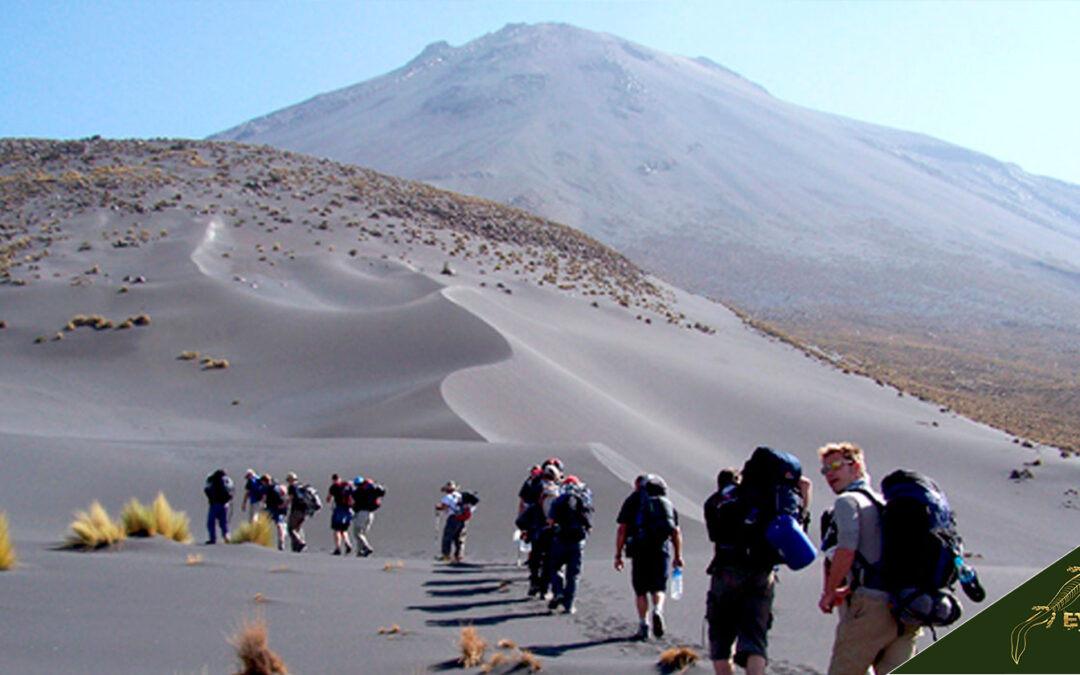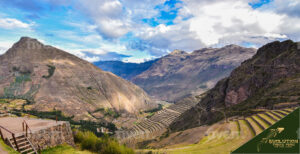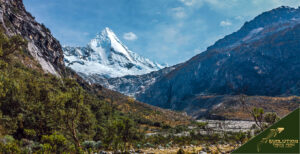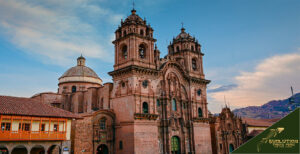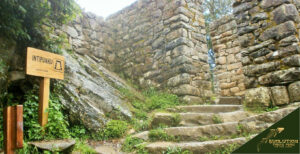Misti, also known as Putina or Guagua Putina, is a stratovolcano of andesite, dacite, and rhyolite located in southern Peru, near the city of Arequipa.
The Misti volcano is located a few kilometers (16) from the city of Arequipa in southern Peru. It is one of the most emblematic attractions of the district of Yanahuara, in the province and department of Arequipa; this volcano is located in the valley of Chili and is only 20 km from the Chachani volcano. El Misti is located within the Salinas y Aguada Blanca National Reserve.
The guardian of the city of Arequipa is approximately 112,000 years old. The successive accumulation of lava and pyroclastic sequences formed it. In the last 50,000 years, it has registered at least 12 volcanic eruptions, whose expelled products have been deposited in great part in the area that today occupies the also-called White City of Arequipa.
One of these eruptions, which occurred 2000 years ago, has been classified as one of the most violent in southern Peru. It reached a Volcanic Explosivity Index of 5 on a scale ranging from 0 to 8. The products emitted were deposited mainly in the southwestern sector of the volcano, where Arequipa is located today. This large eruption also produced pyroclastic flows that slid down Misti’s ravines in the northeast, southwest, and west sectors.
The region was inhabited since pre-Columbian times, and many civilizations feared the volcano’s fury. This led them to perform human and animal sacrifices to appease the wrath of this portentous god.
Misti influenced these cultures’ religious and mystical development for all these reasons. That religious emotion was transmitted from generation to generation, even being the volcano revered and feared in one of the most recognized societies of pre-Hispanic Peru: the Incas. A few years ago, evidence was found of ritual sacrifices performed by the Incas near the volcano’s crater.
There are two-day tours to climb and reach the summit of Misti’s summit and one-day tours that allow you to get close to the base of the volcano. It is recommended to arrive acclimatized and in good physical condition. Currently, much more care is being taken to regulate and allow the ascent of Misti due to the danger of accidents that tourists may suffer, as well as the damage that flora and fauna of the area may suffer from visitors. Unfortunately, in recent months, there have been intentional fires in the Salinas and Aguada Blanca National Reserve.
The Misti volcano rises 5,820 meters above sea level and is still considered active or potentially active.
It is precisely from Misti that Arequipa has obtained one of its most distinctive elements: the sillar. This white volcanic stone was used to build the first houses in the city and can be seen in Arequipa’s oldest, most classic, and elegant buildings.
As for the flora, we find bushes, mahogany, vanilla, sarsaparilla, grasses, and several varieties of exotic tropical flowers. While in the fauna, we can find alpacas, vicuñas, guano birds, cormorants, seagulls, and swallows.
The city of Arequipa, located at the foot of the Misti volcano, is the second most important city (economically and in terms of population) in Peru.
In October 2021 alone, a total of 109,980 passengers arrived at the Alfredo Rodriguez Ballon airport in the White City.
It is estimated that in 2021 – 2022, more than 3.1 million domestic tourism trips will be made to the Arequipa region, which represents 6.8% of total trips nationwide and places it in second place among the most visited regions at the national level.
An average of 100 people ascend Misti each month.
From which country do most tourists come to Peru?
Chile remains the main country of origin, with 906,789 tourists from January to November 2022 and an annual growth of 8.7%. In the same period of the previous year, 833,903 tourists visited Peru. The United States, on the other hand, remains in second place with 492,102 visitors.
What is the history of Misti?
The history of the Misti volcano began about 112,000 years ago. In that time, it recorded at least 12 major volcanic eruptions in the last 50,000 years, expelling debris over the area occupied by the city of Arequipa.
One of these eruptions, which occurred 2000 years ago, has been cataloged as one of the most important in southern Peru. This eruption reached a Volcanic Explosivity Index of 5 on a scale ranging from 0 to 8. The products emitted in this eruption were deposited mainly in the southwestern sector of the volcano, where the city of Arequipa is located today. This large eruption also produced pyroclastic flows that flowed through streams in Misti’s northeast, southwest, and west sectors.
The volcano is still active, which is considered a great danger to Arequipa’s population. However, it has remained “dormant” for several years.
What does Misti mean?
Misti means mestizo or of mixed race. The researcher Masías Núñez del Prado, when referring to the Misti volcano and the city of Arequipa, affirms that the word Misti or Miste has rarely been reflected upon. It has only been said that it means Mestizo.
In Quechua, according to Masías Núñez del Prado, it has no meaning. If it did, it would be an assimilation of the Spanish language.
It is in this language. Suppose the word Misti is not Quechua, Aymara, or Puquina and the meaning attributed to it of Mestizo corresponds to mixed in Spanish. In that case, it is likely that by use, it became MISTI.
This mestizo hypothesis is reinforced by the explanation given by an anonymous author in 1847 about the name of the volcano, “Because…. from its middle, it follows to the east, the cold temperament of the sierra and to the west the temperate and then the hot temperament of the coast. That is why it should have been called Misti, for being mixed in climate.
Consequently, the name Misti is not only of Spanish origin but of late use since it was only called the volcano during 250 years of colonial life.
The name Misti does not have a ritual or cosmogonic connotation. Still, it does have a geographical, poetic, emotional, and historical connotation.
What type of volcano is Misti?
The symmetrical conical shape of El Misti is typical of a stratovolcano, a type of volcano characterized by alternating layers of lava and remnants of explosive eruptions, such as ash and pyroclastic flows. Stratovolcanoes are usually located in the continental crust on a subducting tectonic plate. The magma that feeds the stratovolcanoes of the Andes, including Misti, is associated with the ongoing subduction of the Nazca plate beneath the South American Plate.
When did Misti erupt for the last time?
The last and relatively minor eruption of Misti occurred in 1985. On the other hand, the last time the volcano showed any relevant activity, such as large fumaroles, was in 1870. Current geological studies show that there were five minimal eruptions during the 20th century and a major eruption in the 15th century during the reign of Inca Tupac Yupanqui.
What are the Misti artifacts?
In an expedition carried out by archaeologists Johan Reinhard – the same one who discovered the Juanita mummy (a human mummy belonging to the Inca culture) – and José Antonio Chávez in 1998, several tombs were found inside the volcanic crater. About eight bodies were identified from approximately 550 years ago in this investigation.
The discovery proved that the Incas performed ceremonial sacrifices to calm this aggressive, violent, and unpredictable Apu (a sacred mountain with magical properties in Inca and pre-Inca times).
In the Andean world, it was believed that the gods influenced natural phenomena such as earthquakes, volcanic eruptions, floods, and droughts. For this reason, children were sent as messengers to the gods so that they would return everything to normal.
These sacrifices were performed either by strangulation, a strong blow to the head, or by burying them alive. However, it is uncertain how these eight children died due to the poor conditions in which their remains were found.
On the other hand, some archaeologists prefer to speak of human offerings and not of sacrifices since they assure that it was not something fortuitous and forced but that the participants were people raised and prepared especially for this purpose. Thanks to this, their families acquired benefits and prestige within their community.
Children were raised to honor the gods by offering their lives.
It is said that the Inca priests placed the tombs in places with a high probability of lightning strikes. This was a way of telling the community that the gods answered and accepted the offering.
In many cases, the offering was made to Illapa, the god of thunder, who, according to Inca mythology, was the son of Inti, the sun god, and Quilla, the moon goddess.
When did Misti get its name?
The Misti volcano got its name sometime around the second half of the sixteen century, right after the colonization of the Inca empire.

What purpose did the Andean people living in Arequipa use Misti for?
The region has been inhabited since pre-Columbian times, and many civilizations added a mystical definition to the volcano. For this reason, the eminent power of Misti was feared. This led them to perform human and animal sacrifices to appease the wrath of this fearsome god.
The Misti volcano played an essential role during the religious and mystical development of the cultures that lived in the region. They even influenced the most recognized society of the Peruvian pre-Hispanic era: the Incas. Today, it is one of the most sought-after attractions in Arequipa by tourists and travelers. However, only some have been able to conquer its summit. The Misti volcano is a symbol of culture and history and an invincible force of nature.
What are the theories about the origin of Misti?
- The most important theory about the Misti volcano formation suggests that it was formed through successive layers of ash and lava from powerful eruptions, making it a stratovolcano.
- A second possibility is that the volcano is a shield-type due to its gentle eruption of basaltic lava over time. This theory too is widely supported by scientists.
- A third possible explanation for the formation of Misti is that it is a caldera volcano created by the collapse of the magma chamber within the mountain after a large eruption event.
- Finally, some geologists propose that the Misti volcano could be what’s known as a complex volcano; this would indicate multiple vents and different types of eruptions taking place, resulting in varying features on its surface.
What are the myths about Misti?
Below is a list of the most important myths about Msti volcano.
1. The Legend of Misti Túpac. Legend has it that, many years before the Incas, a young man named Misti Túpac lived in the lands of the current Arequipa region. He was the chief of a tribe of farmers and fishermen, but his character was explosive and very angry. He had superhuman powers, but he used them for evil. Many people made fun of him. Sometimes, he felt so strange about himself that he made people suffer and even killed them with his mental powers. The gods were talking about what to do with Misti Túpac because he was behaving badly.
Then, the god of fire, seeing how unjust and brutal Misti Túpac was with his subjects, wanted to teach him a lesson and stop the suffering of the tribe. Then, the god of fire went up to earth and met Misti Túpac and said to him -You, Misti Túpac, for your actions, I will punish you: you will be a volcano, but not just any volcano, but a sleeping volcano that will never spew lava, so that you do not hurt more people! You will be immobile, and even if you fight with all your might, you will not get away with it.
The god of fire cast a powerful spell on him. Misti Túpac wanted to defend himself, but the god of fire was stronger. While Misti Túpac turned into a rock and increased in size, a shout was heard saying: -I swear that my revenge will be relentless! I will fight to teach them a lesson! The god of fire made it a sleeping volcano. Since then, Misti Túpac fights to break his curse and destroy the nearby populations. When people see smoke coming out of the volcano, Misti Túpac is fighting to fulfill his revenge. For that reason, the volcano is called: “Misti Volcano.”
2. The legend of Misti’s son. According to legend, a mountain known as Misti’s son was born close to its father, Misti. The father volcano erupted ash, water vapor, lava, and fire, causing the earth’s crust to be mortified. As time passed, the concern grew as Misti’s son grew more prominent in a dangerous location, potentially causing the father volcano to erupt and compete with nearby volcano Chachani for existence. Misti, the father volcano, defended its son.
A great confrontation was expected to occur, involving other nearby volcanoes. The local people who lived on the slopes of the chili river were the first to try to prevent the growth of Misti’s son, but they were overwhelmed and decided to relocate. However, strange objects with bright blue and green lights appeared in the sky and landed near the locals. Little men emerged from these objects and made contact with the locals.
They agreed to help, and the locals descended deep into the earth’s surface, where they used magic words to acquire a lot of gold. They returned to their homes and used the gold to make links which they used to chain Misti’s son several months later at night, effectively preventing it from growing any furth.
Is Misti important for the history of Peru?
Yes, The Misti is significant as the most famous volcano in Peru and one of the greatest symbols of the city of Arequipa. Its name is associated with the life, history, culture, and characteristics of the second most important city in Peru, as well as with the temperamental character of the inhabitants of the White City (the name by which Arequipa is also known).
Where is Misti located?
The Misti volcano is located a few kilometers from the city of Arequipa in southern Peru.
It is one of the most emblematic attractions that presents the district of Yanahuara, in the province and department of Arequipa; The volcano is located in the valley of Chili and is only 20 km from the Chachani volcano. It is located within the National Reserve of Salinas and Aguada Blanca.
What are the coordinates of Misti?
The coordinates of Misti are as follows:
Latitude: -16° 17′ 24.00″ S
Longitude: -71° 24′ 19.19″ W

How did Misti become known?
Misti is an active and symmetrical volcano that rises above the white city of Arequipa (2380 meters), the second largest in Peru. This area was an important settlement before the Incas and the Spanish founded the city in 1545. The Arequipa region has a history of earthquakes and eruptions. The White City was severely damaged in 1600 and then rebuilt. El Misti, fortunately, has not had a major eruption since the 15th century. In 1998 several mummies were discovered at the edge of the volcano’s crater, confirming its veneration by the ancient Incas.
El Misti is the most feared and revered symbol of the White City. Its beauty is admired, and its violence is feared. That is why many travelers who come to Arequipa try to climb it. Between five and ten people a week climb its dusty slopes. However, the percentage of people who reach the summit is quite low due to acclimatization and altitude problems in the area.
What is there to see at Misti?
At the highest point of the crater is the eight-meter-long rail cross that was placed in 1900 on the occasion of the advent of the twentieth century. In September 1900, the construction of the cross began in the railroad’s workshop, where seven workers led by Mr. Nicolás Bedoya built it at the request of the Dominican Father Humberto Manrique. The cross measures 10 meters high by 4.5 meters wide, and 50 cm corresponds to the rays placed at the extremities.
The ascent to Misti is also rewarding to discover the wonderful scenery from the top. Not only the cross of Misti is observed, but also the snowy peaks of Chachani and the reliefs of the altiplano, where the dams that supply water to the valley of Arequipa stand out. You also begin to see the interior of the volcano itself. Misti has two craters; the larger one is 900 meters in diameter.
In comparison, the smaller one is only 550 meters and is more off-center, touching the rim or southern limit of the large crater. Located deep inside the current crater, there is a dome made of basic andesitic rock. Through this dome, there are abundant whitish or yellowish-white fumaroles. This protuberance has a diameter of 130 meters, and its central part is elevated 15 meters from its edges.
Walking around the crater rims, it can be observed that the fumaroles emissions are not limited to the inner dome. Still, there are also different cracks through which gases escape. These cracks are pickled on the crater’s edges, even to the outside. Both the gases emanating outside the crater and those that arise in the dome have been captured or sampled to perform the respective geochemical analysis, which will shed light on the true, current state of the magmatic chamber that lies a few thousand meters below.
The information obtained can be compared to other scientific results, such as those captured seismic activity records obtained during a week-long campaign in April 1998. On that occasion, signals of small but unmistakable volcanic seismic activity were detected for the first time. As a result of these discoveries, a permanent seismic station has been built and installed on the volcanic cone, which can detect any seismic movement coming from the volcano. The data is sent in real time, 24 hours a day and throughout the year, via radio telemetry to the Cayma observatories.
In this way, any eruption process brewing at Misti would be known weeks or months in advance.
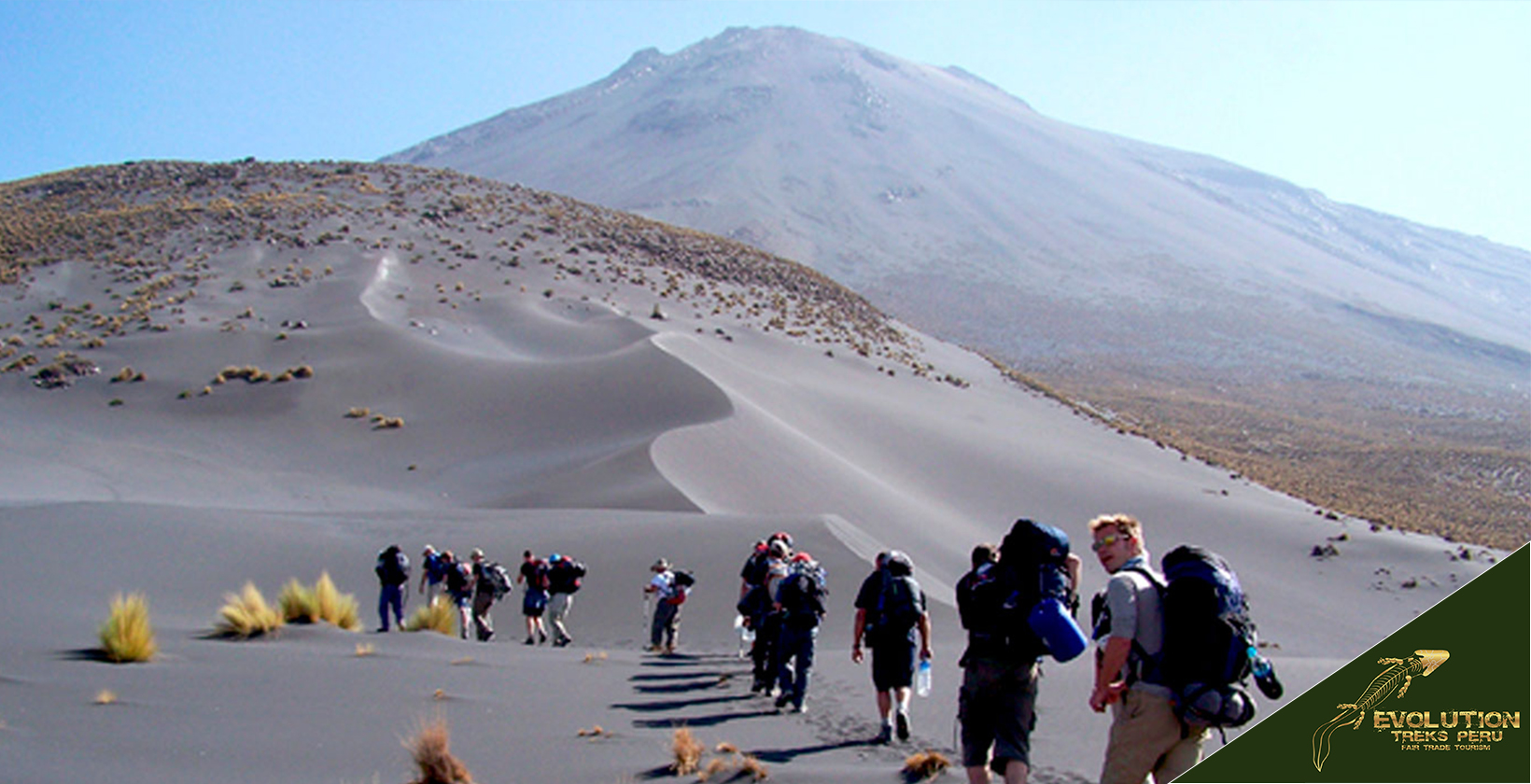
What is the Misti map like?

What is the geography of Misti like?
The Misti volcano is the most striking element of the Arequipa landscape, located at the foot of the Chili River valley. The volcano is the most distinctive of the three snow-capped mountains surrounding the city, along with the Chachani and the Pichu Pichu; as the Arequipa people say, it is not in vain that one is born at the foot of a volcano. It is said that the presence of Misti has a strong influence on the spirit of its inhabitants.
Misti rises 5,820 meters above sea level. Although it has not had a major eruption in years, it is considered active or potentially active.
It is precisely from Misti that Arequipa has obtained one of its most distinctive elements, the sillar. This white volcanic stone was used to build the first houses since the city’s foundation. It can be admired in the oldest and most elegant buildings in Arequipa.
Part of the Misti volcano’s attraction is the history of the people who lived nearby in ancient times. The volcano has always been part of their activities. Even a few years ago, evidence of ritual sacrifices performed by the Incas was found near the volcano’s crater.
As for the flora, you can find bushes, mahogany, vanilla, sarsaparilla, grasses, and several varieties of exotic tropical flowers. While in the fauna, you will find alpacas, vicuñas, guano birds, cormorants, seagulls, and swallows.
What is the geological profile of Misti?
Two buildings form the Misti volcano: Strato volcano containing deposits of the Misti1 group of lower to middle Pleistocene age (833000 < 112,000 years) and Stratocone occurring between 112,000 to 11,000 years, which includes deposits of Misti 2, Misti 3 and Misti 4. These two towers have been built on top of a series of ignimbrites and Vulcan clastic rocks of the Plio-Pleistocene age grouped as “PRE-Misti” deposits.
What are the hiking trails in Misti?
The only way to reach the top of the Misti volcano is by one of the two available trekking routes, either 2, 3 days, or more. The first part of the section must be done by land transport.
Whatever your choice, the itinerary is similar: on the first day, you will arrive at the foothills of the mountain, at 3300 meters above sea level, and make the first ascent of about 6 hours to one of the campsites where you will spend the night. From this point, you can enjoy incredible views of the city of Arequipa and its surroundings.
Please note that this first camp is located at 4500 meters above sea level, so it will be quite cold during the night: a mate de coca tea is recommended to warm up and avoid altitude sickness.
The second day starts very early: you will have to get up around 3 to 4 am to have breakfast and start the hike. It is about a seven/to eight-hour trek to reach the summit.
Once at the top of Misti, you will enjoy a breathtaking landscape: the perfect view of the other two volcanoes of Arequipa, Picchu Picchu and Chacani, the National Reserve of Aguada Blanca and Salinas, the White City and, if the day is clear, you can even see the Pacific Ocean on the horizon.
Returning to the volcano’s base is easy, so it is perfect for enjoying the scenery in peace and quiet.
Several travel agencies in Arequipa offer these two-day, one-night tours for this excursion
To reach the Misti volcano, there are two access routes.
Route 1
Through Chiguata. From the city of Arequipa, we board a private transport that takes us to the town of Chiguata. This town is about 30 km from the city and about 2,970 meters above sea level. From this point, we continue to the base camp to ascend the next day.
In Chiguata, you can appreciate a spectacular landscape composed of terraces and houses built with stone and mud, with a gable roof so that the rain does not damage them. In addition, we also have the Espiritu Santo church from the colonial era. From its dome, 24 carved figures of saints and cherubs can be seen.
Route 2
By Aguada Blanca. From the city of Arequipa, take the road via Cabrerías up to 4,000 meters above sea level until you reach the slopes of Misti. This trip takes approximately three hours. During the journey in the National Reserve of Aguada Blanca and Salinas, we can observe vicuñas, vizcachas, birds such as hawks and eagles, Andean foxes, and even wild guanacos in their natural state.
We walk toward the Aguada Blanca dam (4,250 meters above sea level / 3 hours) to where we will start the base camp (4,800 meters above sea level / 3 hours). From these bases, we start the trekking ascent. The entire uphill trek takes an average of eight hours. The climb must consider the sandy terrain, the dryness of the air, and the altitude.
What is the best time to visit Misti?
The Misti peak can be climbed all year round. Mid-April to October is the ideal time, with usually good weather. However, night temperatures from June to early September can be pretty cold.
November, early December, and April are between, with mostly good weather but more frequent clouds and snow. January to March are the wettest months, and Crampons and ice axes are often needed after a snowstorm.
Where to stay in Misti?
Arequipa, Peru’s second most economically important city, is located a few kilometers from Misti. There you can stay with all the necessary comforts and quietly based on the budget you have calculated.
Here are some suggestions to offer you:
Los Andes Bed & Breakfast: It is a hostel. The staff is very friendly and helpful, the rooms are very clean, and they offer a good breakfast. It is half a block from the Plaza de Armas, a great location with a nice rooftop terrace with amazing views. There are options for private or shared dorms. https://losandesbb.com
Way Kap Hostel: Located behind the Santa Catalina Monastery. A beautiful courtyard is in the center of the hostel, where breakfast is served, and people can hang out. The hostel has shared dorms available. http://way-kap-hostel.arequipahotels24.com/es/
Hotel Katari has a beautiful terrace to watch the sunset, relax, or have breakfast. There is also a restaurant for lunch and dinner. The hotel also offers wellness facilities if you need a massage after exploring the city.
Andean House
Considered one of the most upscale hotels in Arequipa. Casa Andina is divided into three locations and includes a selection of standard, select, and premium rooms. It offers the utmost luxury and comfort for a reasonable price in very convenient locations. It is perfect for guests looking for a place to relax after a long day exploring. Rates for two guests per night range from $60 to $115 USD per night.
The Inn
This is one of the few hotels in Arequipa with a decidedly antique feel. It is a boutique hotel with a beautiful colonial courtyard, ancient arches, and ornate floral arrangements. Standard room rates start at $75 per night, but they also offer two-night and three-day stays that include rafting excursions and visits to the Colca Canyon.
What are the Misti Tours?
Private tours. There are three different kinds of tours of the Misti volcano: private two-day tours and group two-day tours. Private tours are highly recommended for those traveling in small groups or families. They allow for more flexibility as people can customize the tour to suit their needs and interests.
They also get personalized and the guide’s undivided attention, which can be highly beneficial if you have questions or concerns. In addition, private tours allow people to move at their own pace, and the tour can be tailored to your fitness level. Also, people have more privacy and exclusivity, which can be especially beneficial for those who want to avoid large crowds.
Private tours are only recommended for people with prior experience climbing mountains or in poor physical condition. The price of a private tour starts at 550 Peruvian soles plus other add-ons such as extra porters, sleeping bags, pads, etc.
Group tours have daily departures but need more flexibility and personalized attention. With a group tour, you may receive a different level of personal attention and guidance than a private tour. Also, you get less comfort, and you may have to keep up with the group’s pace, which may be challenging for some people.
Group tours have some benefits; however, they are cheaper than private tours, which are the perfect fit for those traveling on a budget. The price of a group tour ranges between 280 soles and 350 soles.
Very important. Climbing the Misti volcano requires a certain level of physical fitness as it can be strenuous and challenging. The ascent to the summit involves hiking on steep and uneven terrain, often at high altitudes and at dark. The lack of oxygen at higher elevations can make climbing more difficult; proper acclimatization before the trek is required.
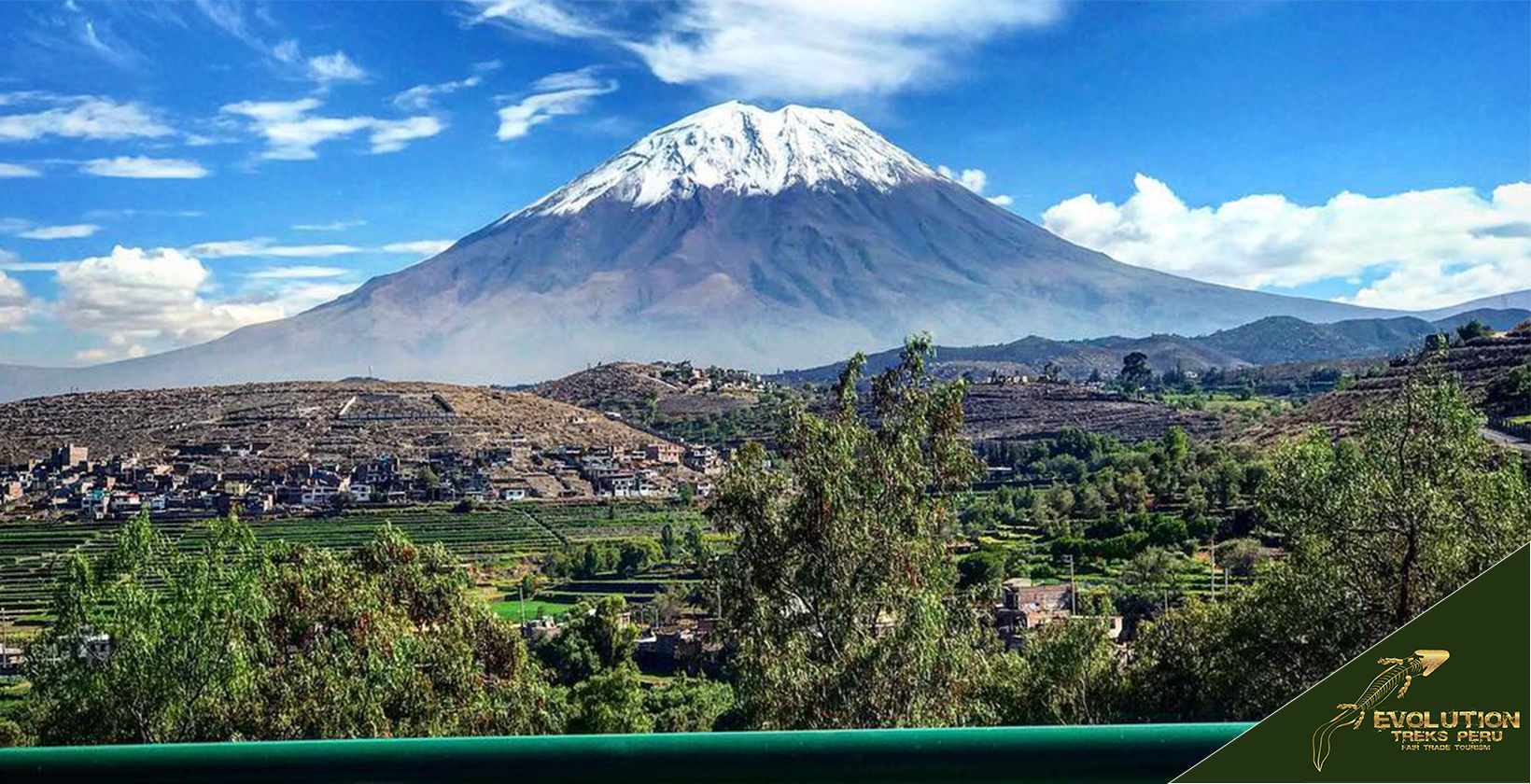
How to get from Arequipa to Misti?
To access the Misti volcano, there are two routes:
Route 1 Chiguata: Chiguata is located about 30 km from the city of Arequipa and can be reached by boarding a private vehicle that leaves you in this town located at 2970 masl, and from here you start the hike to the base camp, where you spend the morning of the next day to climb to the top of Misti (5825 masl).
In Chiguata, you can get a spectacular view of terraces and houses built with stones and mud.
Route 2 Aguada Blanca Trail: This route takes us through the Aguada Blanca reserve, where wild auquénidos, such as vicuñas, are preserved.
To reach this place, we must go from Arequipa on a journey of approximately 3 hours to ascend to 4000 meters above sea level in the CABRERÍAS and then continue to the slopes of Misti Volcano.
From the volcano’s base begins the ascent to Misti; the route is ascending, which is more complicated than route 1. The ascent takes an average of 8 hours.
What to know before going to Misti?
Below is a list of the most important things you need to know before climbing the Misti Volcano.
- First and foremost, ensure you are prepared for the challenging ascent up the Misti Volcano. Bring plenty of water, energy-boosting snacks, and sun protection such as sunscreen and a hat.
- Check the weather forecast. The weather in Arequipa can be unpredictable, and it is crucial to plan your climb accordingly.
- Acclimatize in advance. Be aware of altitude sickness – this may affect some climbers not used to high altitudes, such as those encountered while climbing Misti Volcano. It is recommended that you acclimatize before undertaking this complicated feat.
- Research the route before you climb – arrange for a pre-trek presentation with your tour guide before the hike, and get them to explain the route step by step and hour by hour.
- Wear suitable clothing – avoid cotton clothing that absorbs moisture; instead, opt for breathable layers such as dry-fit baselayers, windbreakers, or down jackets.
- Prepare for harsh weather conditions – temperatures can drop quickly during the night, especially at higher altitudes, and strong winds may occur. Bring appropriate rainwear and warm clothes, just in case.
- Pack a first aid kit with essential items such as bandages, antiseptic wipes, painkillers, and any other medications or items you may need in an emergency.
- Monitor local news, Facebook groups, and others regarding any potential hazards or warnings related to climbing Misti Volcano before your departure date.
- Familiarize yourself with potential environmental hazards during the climb, such as rockslides or avalanches that could cause injury or damage property if not correctly managed.
- Know where the nearest medical facilities are located in case an accident occurs during your ascent up Misti Volcano – this will help keep you safe, especially if there are no other climbers around at the time of your departure date or if you take a private tour.
- You should also bring plenty of water with you on your climb. It is essential to stay hydrated throughout the ascent.
- Prepare for varying terrain; Parts of the climb may be steep and require some scrambling, while others may be more gradual.
- Bring appropriate clothing and footwear; The Misti volcano is located in an area that experiences strong winds, so make sure you bring a jacket or windbreaker and sturdy shoes with good traction.
- Pack snacks for energy; You will need extra energy for the strenuous climb up the Misti Volcano, so pack some snacks or bars for fuel along the way.
How much does it cost to visit Misti?
Touring companies offer complete guided packages that range from 180-250 USD for one customer, 160-225 USD for two customers, and 100-150 USD for five or more. Transportation from downtown to the trailhead and back is an additional 50-70 USD, depending on the quality of the 4×4 truck used. Additionally, guiding services for ascending high peaks, such as El Misti, are charged 70-100 USD daily.
How many days should a person spend in the Misti volcano?
The average length of a tour of the Misti volcano is two days. Most tour operators offer 2-day treks and some other offer a one-day trek too. The latter is recommended to experienced hikers who have acclimatized to the altitude already.
Which is the closest city to Misti?
Arequipa city is the closest city to the Misti volcano. It is located 16 km away from the center of Arequipa.
How is Misti’s past presented to visitors?
The Misti volcano is presented to visitors as the guardian of Arequipa, the one who look over the lives of its people and its livelyhood. People fro Arequipa feel immensely proud of living under its feet and show that pride to everyone who visits Arequipa. Also, other people who are not from Arequipa, such as the Stowaway magazine present Arequipa as one of the seven wonders of Peru and gloriify its beauty with the following words;
‘One of Peru’s most mysterious active volcanoes sits casually on the edge of the country’s second-largest city, Arequipa. At 4,000 meters high, Misti is the only guardian towering over the white rock city. As its last major explosion was in 1985, one may approach the giant with stories of Pompeii and Vesuvius in mind.
However, many hikers, climbers, explorers, and locals have enjoyed exploring this wonderful, and you can too. El Misti offers several permit-free hiking and climbing routes. It takes two to three days to climb the volcano. You must hike with an accredited tour guide in Arequipa (When choosing a guide, ask to see the little black book that identifies trained guides). The volcano’s base is only 16 kilometers from the city center, so getting there and back is fine. Getting up and down is the hard part.’
How is Misti preserved?
The current state of conservation is good. Access to the Salinas and Aguada Blanca National Reserve and the ascent to the Misti volcano is being more strictly regulated to avoid further damage to the environment and surroundings. However, a current concern is a damage to flora and fauna caused by the fires occurring in the valley at the foot of Misti and the damage caused by waste and garbage left behind by visitors. Further work of preservation is being done by SERNANP in the area.
Is Misti a UNESCO World Heritage Site?
No, The Misit Volcano is a UNESCO’s world heritage site. However, On December 2, 2000, the Historical center of the city of Arequipa was declared a World Heritage Site by the United Nations Educational, Scientific and Cultural Organization (UNESCO) in recognition of its architectural beauty and the landscape reserve of the countryside.
Is the Misti volcano endagered?
Yes, The natural areas around the Misti volcano are endangered due to mismanagement on behalf of tour operators. The influx of people who decide to climb Arequipa’s volcanoes has harmed its flora and fauna. Numerous reports have been of climbers leaving behind garbage along their path and lighting bonfires that cause forest fires that threaten animals’ natural habitats. All these factors have created a dangerous situation for humans and wildlife, with potential long-term implications for the environment if not addressed promptly.
To conserve flora and fauna around the Misti and Chachani volcanoes located in the Arequipa region, the ascent to these massifs will be regulated. This is according to information presented by the National Service of Natural Areas Protected by the State (Sernanp).
In the meantime, Sernanp personnel have already met with the 11 tourist agencies that offer the Misti ascent service to ensure that they make exclusive use of the existing roads that lead to the summit and take particular care with the management of solid waste.
According to the Sernanp study, an average of 100 people visit Misti every month. Although this number does not generate a burden on the snow-capped mountain, it is necessary to regulate it to protect the surrounding flora and fauna.
Is Misti an active volcano?
Misti volcano is the best-known volcano in Peru and one of the most active. It is a symmetrical andesitic stratovolcano overlooking the city of Arequipa, just 16 km to the southwest. Its proximity to Peru’s second-largest city and its history of explosive eruptions make it one of the most dangerous volcanoes in the world.
According to the last population census conducted by the National Institute of Statistics and Informatics (INEI) in 2017, the province of Arequipa is inhabited by more than 1 080 635 people. Only in the districts directly bordering the Misti volcano, such as Alto Selva Alegre, Miraflores, Mariano Melgar, Paucarpata, and Chiguata, today inhabit more than 340 000 people according to INEI data.
This proximity to the population and the presence of energy, hydraulic, and transportation infrastructure make Misti a high-risk volcano.
Every day, between 40 and 60 earthquakes occur at Misti volcano that are invisible to the population of Arequipa. The IGP, through the National Volcanological Center (CENVUL), has been monitoring Misti permanently and in real-time since 2005 through a geophysical network consisting of 6 seismometers, 1 GPS station, and 2 scientific cameras.
Is El Misti in the Pacific Ring of Fire?
Yes, the Misti volcano is located in the Pacific “Ring of Fire”. The Ring of Fire, also known as the is a 40,000-kilometer-long region home to several oceanic plates constantly sliding beneath the continents of the Americas and Asia.
This belt covers about 40 countries, including Peru. The Pacific Ring of Fire has the world’s highest number of seismic movements. It is so called because it borders sites encompassing the crossing of 6 tectonic plates in constant movement. On them rests the Pacific Ocean, which is in the middle of 40 countries, which are home to a total of 452 volcanoes and more than 75% of the active and inactive volcanoes in the world.
About 90 % of the world’s and 80 % of the largest earthquakes have occurred in this location.
At this site, the plates sink several centimeters per year, accumulating a lot of tension, which must be released through earthquakes.
Tectonic plates are always in motion and have friction. When energy is released, earthquakes are produced.
Six plates are part of the Ring of Fire: the Pacific Plate, the South American Plate, the Nazca Plate, the North American Plate, the Philippine Plate, and the Australian Plate.
If the ring of fire is activated, earthquakes will occur in all countries in the zones specified above. To this would be added the eruption of the volcanoes that are part of it.
Volcanoes surrounded by towns or cities affect the place’s life (human, wild, and nature) when they erupt. In the case of earthquakes, their effect is also devastating, leaving thousands of victims and people without lives. With the population growth in the two continents involved, the death toll would increase exponentially.
The impact would be fatal in Peru since the country has a considerable number of volcanoes. However, the Peruvian Geophysical Institute (IGP) is constantly monitoring the Ubinas (Moquegua) and Misti (Arequipa) volcanoes, which are active and could cause the most damage to the population.

Miguel is a professional tour guide from Cusco, Peru, with almost 20 years of experience leading tours and a deep knowledge of Peru’s cultural and ecological diversity. He is also an advocate of ecotourism and cultural sensitivity and has lectured on these topics in the US and Europe. He co-founded Evolution Treks Peru, a worker-owned travel company based in Cusco.

